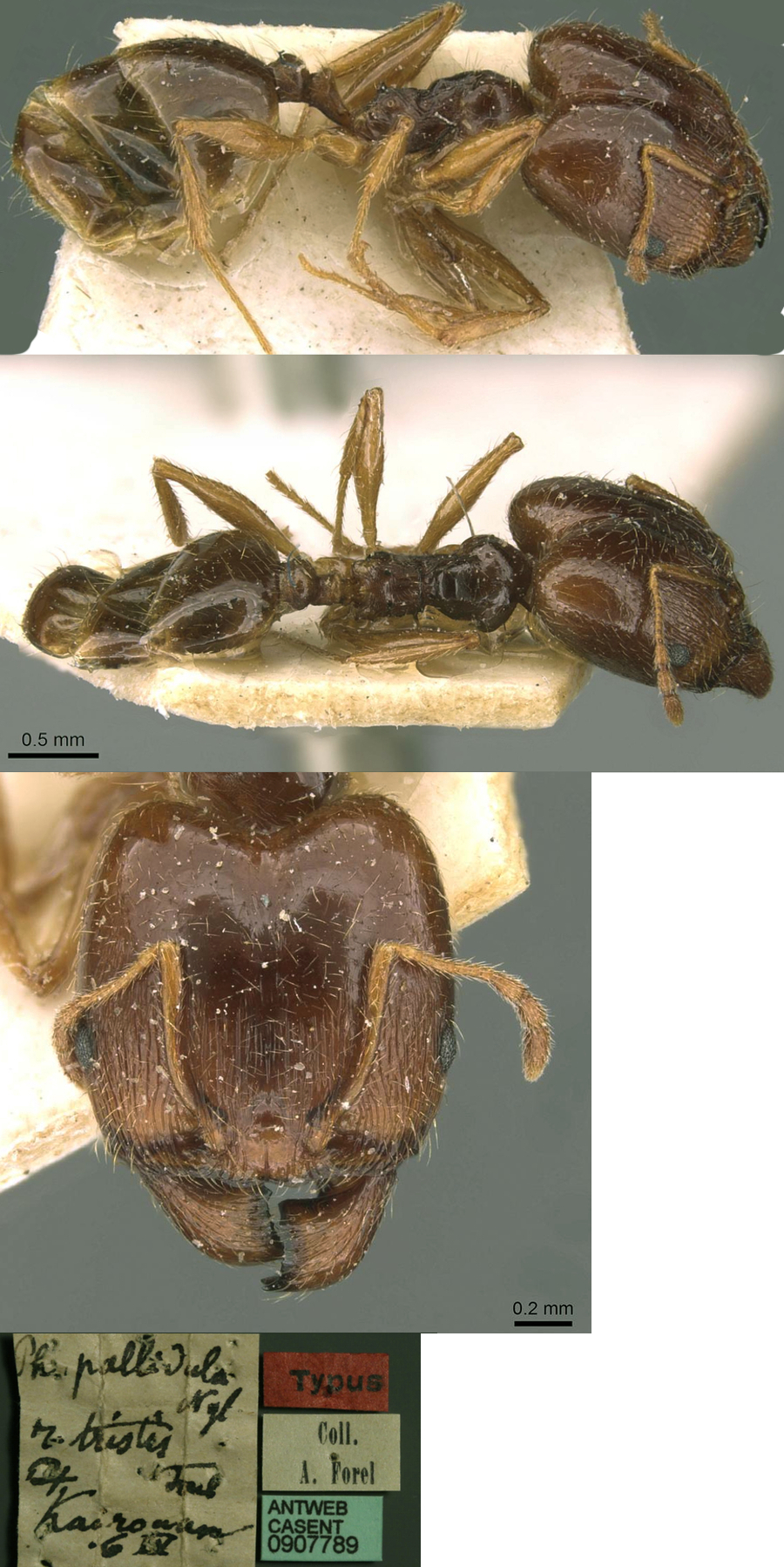Pheidole cicatricosa Stitz - majors
 Main species page Main species page
|
 Photomontage
of the major worker of Pheidole pallidula
Nyl. v. cicatricosa n.v. of Stitz (1917: 340); from Algeria,
Oued
Agelil, 30.i.1914, collected by V Geyer. Photomontage
of the major worker of Pheidole pallidula
Nyl. v. cicatricosa n.v. of Stitz (1917: 340); from Algeria,
Oued
Agelil, 30.i.1914, collected by V Geyer.
Note: I have applied minor colour corrections to the
FoCol (slight reduction in brightness) and Antweb images (shift in
balance of magenta-green tone).
|
 The photomontage of the tristis type
major worker is collated
from http://www.antweb.org/specimen.do?name=casent0907789. The photomontage of the tristis type
major worker is collated
from http://www.antweb.org/specimen.do?name=casent0907789.
|
 The photomontage of the
recticeps type
major worker is collated
from http://www.antweb.org/specimen.do?name=casent0907791. The photomontage of the
recticeps type
major worker is collated
from http://www.antweb.org/specimen.do?name=casent0907791.
|
MAJOR - new description TL 4.0-4.5 mm; Zaranik
specimens CI 93 SI 63 OI 128; El Minia specimens CI 100 SI 57 OI 12
Head in full face view slightly elongate cordate with a deeply
impressed occiput
Mandibles quite large and heavy but with a thin inner, masticatory
margin; with two basal teeth and two sharp apical teeth; sculptured
basally with rugae and distinctive minute hair pits giving rise to an
abundance of short, thickish decumbent hairs
Clypeus shiny with numerous weak longitudinal carinae but only a poorly
defined median carina; the anterior margin is markedly sinuous with a
quite deep median impression
Frontal carinae reaching the mid-point of the face and quite strongly
divergent posteriorly
Antennae with both scapes and funiculi slender but moderately long;
funiculus segments 2-7 all longer than they are wide; the apical
segment is about as long as the two pre-apical segments together
Eye small and circular (9-10 facets long X 9-10 wide); set about twice
its own length back from the lateral margin of the clypeus
Hypostoma with small submedian teeth and paired large lateral teeth;
underside of head with very weak transverse anterior rugulation and
shiny
Alitrunk profile with a flat-topped pronotum, then a drop to the
mesonotum which has quite prominent posterior tubercles, those in turn
drop vertically into a quite strongly impressed metanotal groove; the
propodeum profile is flat with relatively large triangular teeth; the
dorsum of the propodeum has a pronounced longitudinal groove which
widens from front to back
In profile the petiole rises in a straight angle from the front of the
pedicel to the apex of the sharply angled node, with the posterior
faced vertical; the upper margin of the node is not impressed
The postpetiole profile is small and globular, from above it is ovoid,
more than twice as wide as the petiole, and has distinctive lateral
processes set at the ends of the dorsum
The gaster is distinctly smaller than the head and ovoid in profile and
from above
Erect pilosity quite long, fine and quite abundant; pubescence short,
adpressed but quite abundant.
Overall appearance shiny; the head has quite strong striate
sculpturation on the face and laterally; the mesonotum and propodeum
wappear rough with distinct but ill-defined longitudinal striations,
the propodeal dorsum has tranverse striations
The general colour is dark red-brown, with the gaster and mandibles
darker; speculatively the type of cicatricosa has lost much of
its colour since it was collected in 1914.
|
 The
photomontage is of a major from Egypt, Zaranik, 30°39'N
34°26'E; 4.v.2003; collected by Mostafa Sharaf. The
photomontage is of a major from Egypt, Zaranik, 30°39'N
34°26'E; 4.v.2003; collected by Mostafa Sharaf.
|
 The
photomontage is of a second set of majors from Egypt, El-Minia,
2008, collected by Mahmoud Fadl Ali. The
photomontage is of a second set of majors from Egypt, El-Minia,
2008, collected by Mahmoud Fadl Ali.
|
 Photomontage of a
major
specimen collected in Spain, Garden Costa i Llobera, Barcelona,
by Xavier Espadaler. The location is a dry cactus garden and Xavier
commented (in litt) - "it seemed to me they were too big for P.
pallidula". Photomontage of a
major
specimen collected in Spain, Garden Costa i Llobera, Barcelona,
by Xavier Espadaler. The location is a dry cactus garden and Xavier
commented (in litt) - "it seemed to me they were too big for P.
pallidula".
|
|